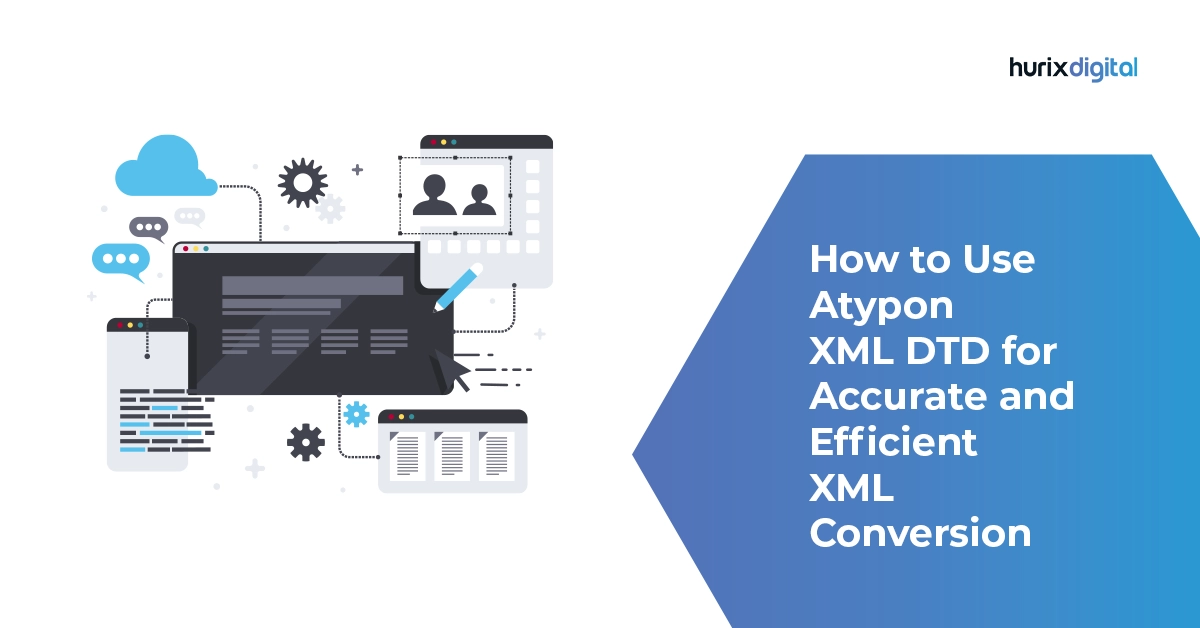
How to Use Atypon XML DTD for Accurate and Efficient XML Conversion?
Summary
This blog provides you with a thorough understanding of Atypon XML DTD and its role in the world of digital publishing. It also highlights the benefits of Atypon XML DTD and how it can be used to transform your content.
In the fast-paced world of digital publishing, staying ahead of the competition and delivering high-quality content to readers is crucial. Publishers need advanced tools and technologies to transform their content seamlessly from one format to another. XML conversion has become a popular choice due to its flexibility and structured nature, enabling better content management and distribution. One such powerful tool in the XML conversion realm is Atypon XML DTD.
In this blog, we dive deep into the world of Atypon XML DTD and understand how it can help you.
Table of Contents:
- What is Atypon XML DTD?
- Why is Atypon XML DTD Important?
- How can Atypon XML DTD be Helpful?
- When can Atypon XML DTD be Used?
- The Power of Atypon XML DTD in Digital Publishing
- Conclusion
What is Atypon XML DTD?
Atypon XML DTD is a specialized Document Type Definition (DTD) designed by Atypon, a leading provider of publishing technology solutions. It serves as a blueprint that defines the structure and rules for creating XML documents tailored specifically for online publishing. In simpler terms, it sets the guidelines for how content should be structured, tagged, and presented.
Why is Atypon XML DTD Important?
In the world of digital publishing, accuracy, and consistency are paramount. Atypon XML DTD plays a crucial role in ensuring that content is uniformly formatted, making it easier for publishers to manage and maintain large volumes of data. By adhering to the standardized structure provided by Atypon XML DTD, publishers can create content that is easily discoverable and accessible to their target audience, leading to an enhanced user experience.
Also Read: Understanding the Concept of First XML Workflow in Journal Publishing
How can Atypon XML DTD be Helpful?
1. Structured Content Management
Atypon XML DTD helps publishers create content in a structured manner, dividing it into logical sections with appropriate tags. This organized approach enables efficient content management, making it easier to update, repurpose, or export content for various platforms.
2. Content Transformation and Reusability
XML conversion using Atypon XML DTD allows content to be transformed and repurposed effortlessly. Publishers can seamlessly adapt their content to different devices, screen sizes, or formats without the need to recreate it from scratch.
3. Enhanced Collaboration
When multiple contributors are involved in the content creation process, it’s crucial to maintain consistency and avoid conflicting styles. Atypon XML DTD ensures that all contributors adhere to the same guidelines, resulting in a coherent final product.
4. Streamlined Publishing Workflow
With Atypon XML DTD, the publishing workflow becomes more streamlined. Authors can focus on creating content while the XML conversion process takes care of formatting, layout, and cross-referencing, saving valuable time and resources.
5. Search Engine Optimization (SEO)
Atypon XML DTD enables publishers to optimize content for search engines. XML tagging helps search engines understand the structure and context of the content, leading to better visibility and higher rankings in search results.
6. Data Interoperability
Atypon XML DTD fosters data interoperability, allowing publishers to integrate content from various sources and systems seamlessly. This enables them to combine and present diverse content types, such as text, images, multimedia, and more, coherently.
When can Atypon XML DTD be Used?
Atypon XML DTD can be utilized in various scenarios:
- Journal Articles and Research Papers: For academic publishers, Atypon XML DTD is a powerful tool for organizing complex data, citations, and references in scholarly articles, ensuring accuracy and precision.
- eBooks and Digital Publications: XML conversion with Atypon XML DTD enables seamless eBook production, catering to various e-readers and devices, providing a consistent reading experience for users.
- Journals and Magazines: Atypon XML DTD simplifies the layout and presentation of digital journals and magazines, optimizing content for web-based publishing.
- Content Aggregation and Syndication: Publishers dealing with content syndication across multiple platforms can leverage Atypon XML DTD to distribute content efficiently while maintaining its integrity.
- Archiving and Preservation: Atypon XML DTD helps preserve content for the long term, ensuring that it remains accessible and usable even as technology evolves.
- Personalization and Targeting: Publishers can leverage Atypon XML DTD to create personalized content experiences for their readers. The structured XML format allows for dynamic content delivery, targeting specific audience segments, and enhancing user engagement.
Also Read: How to Convert HTML to XML Efficiently?
The Power of Atypon XML DTD in Digital Publishing
The digital publishing landscape is constantly evolving, and Atypon XML DTD provides much-needed technological support to publishers, ensuring that their content is accurately and efficiently transformed for online consumption. By leveraging Atypon XML DTD, publishers can streamline their content transformation process, enhance collaboration among authors and editorial teams, and deliver a superior reading experience to their audience.
The structured nature of XML allows publishers to maintain consistency across multiple platforms and devices, reducing the risk of errors and ensuring a seamless experience for readers. Moreover, Atypon XML DTD enables content to be easily repurposed for various formats, ensuring that publishers can adapt to changing market demands without extensive investments in time and resources.
Conclusion
If you’re looking to revolutionize your digital publishing experience and harness the benefits of Atypon XML DTD, Hurix Digital is here to assist you. With their expertise in content transformation and cutting-edge publishing solutions, Hurix Digital can help you streamline your publishing workflow, boost audience engagement, and deliver outstanding content to your readers.
Hurix Digital has a proven track record of empowering publishers with innovative solutions that enhance content management, optimize publishing workflows, and elevate the overall reading experience. Their team of experts can guide you through the process of integrating Atypon XML DTD into your digital publishing strategy, ensuring seamless content transformation and exceptional results.
Get in touch with Hurix Digital now!

A Delivery Manager at Hurix with nearly 5 years of experience in digital transformation projects for Education Publishing and over two decades in the industry. I specialize in quality projects like Design for Six Sigma and Lean programs and have extensive experience in training, project management, and client relations.






